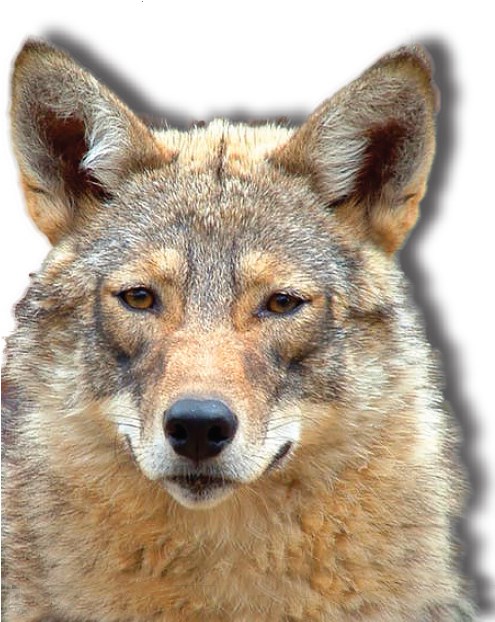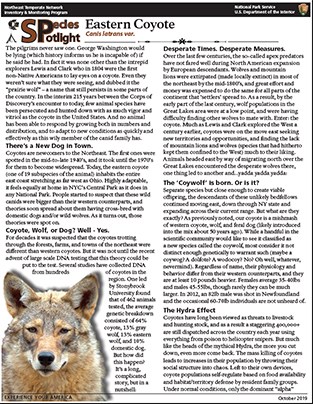Last updated: November 29, 2022
Article
NETN Species Spotlight - Eastern Coyote


The pilgrims never saw one. George Washington would be lying (which history informs us he is incapable of) if he said he had. In fact it was none other than the intrepid explorers Lewis and Clark who in 1804 were the first non-Native Americans to lay eyes on a coyote. Even they weren’t sure what they were seeing, and dubbed it the “prairie wolf” – a name that still persists in some parts of the country. In the interim 215 years between the Corps of Discovery’s encounter to today, few animal species have been persecuted and hunted down with as much vigor and vitriol as the coyote in the United States. And no animal has been able to respond by growing both in numbers and distribution, and to adapt to new conditions as quickly and effectively as this wily member of the canid family has.
There’s a New Dog in Town.
Coyotes are newcomers to the Northeast. The first ones were spotted in the mid-to-late 1940’s, and it took until the 1970’s for them to become widespread. Today, the eastern coyote (one of 19 subspecies of the animal) inhabits the entire east coast stretching as far west as Ohio. Highly adaptable, it feels equally at home in NYC’s Central Park as it does in any National Park. People started to suspect that these wild canids were bigger than their western counterparts, and theories soon spread about them having cross-bred with domestic dogs and/or wild wolves. As it turns out, those theories were spot on.
Coyote, Wolf, or Dog? Well - Yes.
For decades it was suspected that the coyotes trotting through the forests, farms, and towns of the northeast were different than western coyotes. But it was not until the recent advent of large scale DNA testing that this theory could be put to the test. Several studies have collected DNA from hundreds of coyotes in the region. One led by Stonybrook University found that of 462 animals tested, the average genetic breakdown consisted of 64% coyote, 13% gray wolf, 13% eastern wolf, and 10% domestic dog. But how did this happen? It’s a long, complicated story, but in a nutshell:
Desperate Times. Desperate Measures.
Over the last few centuries, the so-called apex predators have not fared well during North American expansion by European descendants. Wolves and mountain lions were extirpated (made locally extinct) in most of the northeast by the mid-1800’s, and great effort and money was expensed to do the same for all parts of the continent that ‘settlers’ spread to. As a result, by the early part of the last century, wolf populations in the Great Lakes area were at a low point, and were having difficulty finding other wolves to mate with. Enter: the coyote. Much as Lewis and Clark explored the West a century earlier, coyotes were on the move east seeking new territories and opportunities, and finding the lack of mountain lions and wolves (species that had hitherto kept them confined to the West) much to their liking. Animals headed east by way of migrating north over the Great Lakes encountered the desperate wolves there, one thing led to another and...yadda yadda yadda:
The ‘Coywolf’ is born. Or is it?
Separate species but close enough to create viable offspring, the descendants of these unlikely bedfellows continued moving east, down through NY state and expanding across their current range. But what are they exactly? As previously noted, our coyote is a mishmash of western coyote, wolf, and feral dog (likely introduced into the mix about 50 years ago). While a handful in the scientific community would like to see it classified as a new species called the coywolf, most consider it not distinct enough genetically to warrant such (maybe a coywog? A dolfote? A wodocoy? No? Oh well, whatever, nevermind). Regardless of name, their physiology and behavior differ from their western counterparts, and they are at least 10 pounds heavier. Females average 35-40lbs and males 45-55lbs, though rarely they can be much larger. In 2012, an 82lb male was shot in Newfoundland and the occasional 60-70lb individuals are not unheard of.

The Hydra Effect
Coyotes have long been viewed as threats to livestock and hunting stock, and as a result a staggering 400,000+ are still dispatched across the country each year using everything from poison to helicopter snipers. But much like the heads of the mythical Hydra, the more you cut down, even more come back. The mass killing of coyotes leads to increases in their population by throwing their social structure into chaos. Left to their own devices, coyote populations self-regulate based on food availability and habitat/territory defense by resident family groups. Under normal conditions, only the dominant “alpha” male and female breed, while behaviorally suppressing reproduction among coyotes of lesser status. When one or both alphas are killed, these social bonds break and a kind-of power vacuum is formed with multiple pairs of coyotes vying for dominance leading to more breeding at younger ages and dozens more pups birthed, which often spread to new territories. In a seemingly counter-intuitive formula: in most cases the less coyotes you kill, the less you’ll have.
Game Vs. Predator
It isn’t surprising that an animal of mixed genetics has a coalesced kaleidoscope of traits from each species, and is a likely reason they are so adaptable. As a mid-sized predator, coyotes are opportunists. They hunt for prey both large and small, scavenge dead animals, and forage for fruits, nuts, and vegetables. The majority of their diverse diet consists of small to mid-sized mammals (60%), but birds, amphibians, reptiles, fish, and insects are also on the menu. A 5-year study in NY showed that deer fawns are an important food source in spring and early summer. In winters with deep snow, family packs are capable of taking down the occasional adult deer - mostly ones that are already injured (being hit by cars is a big contributing factor) or diseased. Even with small game and deer being important parts of their diet, coyotes do not appear to reduce game numbers in the east. Nonetheless many in the hunting community hold long-standing concerns about coyote’s (and other predators) impacts on regional populations. A statement by the Pennsylvania Game Commission released in 2016 tried to put these concerns to rest by denoting that “[predators] don’t compete with our hunters for game” and “to pretend that predator control can return small game hunting to the state is a false prophecy.” Wildlife studies have shown time and again that habitat protection is the #1 most important contributing factor in promoting healthy small game numbers. Likewise, the North Carolina Wildlife Resources Commission recently stated “most coyote diet studies document low-to-no prevalence of wild turkey or other game birds in diets,” and that coyotes may actually benefit quail and waterfowl birds by inhibiting the presence of smaller, more bird dependent predators like raccoon and fox. Furthermore, they continued: “while predation on adult deer has been documented, it is uncommon, and hunter harvest remains as the primary source of adult mortality” “...the most effective method to increase or stabilize deer numbers at statewide and regional scales is through regulatory changes in season lengths, bag limits, and timing of harvest.”
Packing it In
In another hybrid trait, eastern coyotes do sometimes form packs. But they’re less complicated arrangements of social status and extended family groups than wolf packs are, usually consisting of a mated pair and their offspring of 2 or 3 pups. When they get together for a group howl though, it can sound like many more animals. Meanings behind coyote vocalizations are myriad. One oft repeated sub-urban legend holds they howl to either announce they are off for the hunt or to celebrate a recent kill, but both bark up the wrong tree. The last thing coyotes would want to do is attract competing coyotes or other predators to their hard earned kill, or to announce their presence to any nearby prey before a hunt. Their howls, yips, and barks likely have more to do with cementing family bonds and defending/establishing territory.For more information
- Read the full statement on predator impacts on game species by the Pennsylvania Game Commission.- Watch this video from Vermont PBS to hear howls and see how many area hunters are learning to live with, even respect, the coyote.

Tags
- acadia national park
- appalachian national scenic trail
- eleanor roosevelt national historic site
- home of franklin d roosevelt national historic site
- marsh - billings - rockefeller national historical park
- minute man national historical park
- morristown national historical park
- saint-gaudens national historical park
- salem maritime national historic site
- saratoga national historical park
- saugus iron works national historic site
- vanderbilt mansion national historic site
- weir farm national historical park
- species spotlight
- netn
- inventory and monitoring division
- mammals
- eastern coyote
- coyote
- predators
- science
